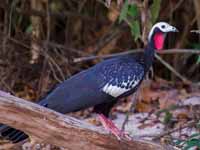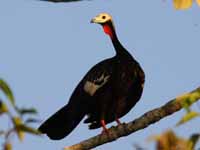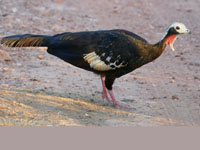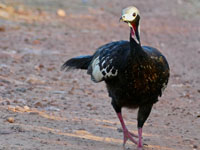THE WORLD BIRDS - An Online Bird Book
GALLIFORMES
GALLIFORMES
Galliformes are heavy-bodied ground-feeding domestic or game birds. Most are plump-bodied with thick necks and moderately long legs, and have rounded and rather short wings. They do not fly well if at all, but walk and run instead for transportation. These birds vary greatly in size from 12-120 cm. Many adult males have one to several sharp horny spurs on the back of each leg, which they use for fighting. They can be found worldwide and in a variety of habitats, including forests, deserts, and meadows. Male courtship behavior includes elaborate visual displays of plumage. Gallinaceous birds feed on a variety of plant and animal material, which may include fruits, seeds, leaves, shoots, flowers, tubers, roots, insects, snails, worms, lizards, snakes, small rodents, and eggs.
Family Phasianidae: francolin, grouse, partridge, pheasant, quail.
Family Cracidae: chachalac, curassow, guan.
Family Phasianidae: francolin, grouse, partridge, pheasant, quail.
Family Cracidae: chachalac, curassow, guan.
Cracids are large birds, similar in general appearance to turkeys. The guans and curassows live in trees, but the smaller chachalacas are found in more open scrubby habitats. Many species are fairly long tailed, which may be an aide to navigating their largely arboreal existence. They are generally dull-plumaged, but the curassows and some guans have colourful facial ornaments. The birds in this family are particularly vocal, with the chachalacas taking their name from the sound of their call.
Genus Aburria - 1 species
Guan,_Wattled Aburria aburri Found: Colombia, Ecuador, Peru, Venezuela
The Wattled Guan has mainly glossy black plumage; yellow wattle hangs from throat.
Image by: 1) Ron Knight 2) Alejandro Tamayo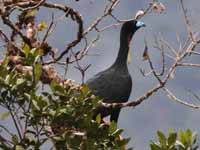
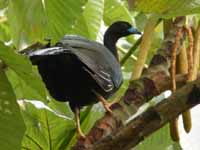
Genus Chamaepetes
Guan,_Black Chamaepetes unicolor Found: Costa Rica, Panama
The Black Guan has black plumage; blue facial skin.
Image by: 1) Charles J Sharp - Costa Rica 2) Hans Switzer - Costa Rica 3) Benjamin Keen - Costa Rica 4) Nick Athanas - CR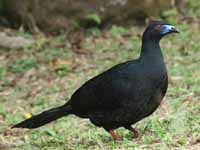



Guan,_Sickled-winged Chamaepetes goudotii Found: South America
The Sickled-winged Guan has blue facial skin; rufous underparts. It is found in Bolivia, Colombia, Ecuador, and Peru.
Image by: 1) Jerry Oldenettel - Ecuador 2) Beatrice Murch 3) Andrew_Neild 4, 5) Nick Athanas - Ecuador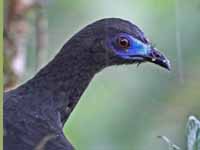
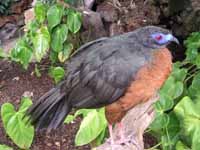

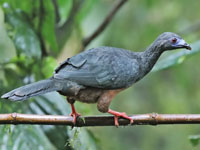
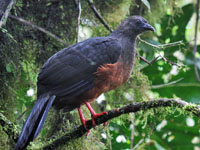
Genus Crax
One of two genus of curassows. Pauxi is the other genus.
Curassow, Bare-faced Crax fasciolata Found: South America
The male Bare-face Curassow has mainly glossy black plumage; yellow bill with dark tip; gray bare eye-ring; white lower belly; dark legs. Female has mainly black plumage with white bars; yellowish-brown lower belly; dark brown bill; bare eye-ring; pink legs.
It is found in Brazil, Paraguay, eastern Bolivia, and extreme northeast Argentina.
Similar to: Black Curassow. Black Curassow has lusher crest than Bare-faced Curassow. Bare-face Curassow has more bare skin on face than Black Curassow.
Image by: 1) Ronald Woan - Brazil 2, 7) Charles Sharp 3) Hecht1969
4) Bruno Girin - Brazil 5) Valter Jacinto 6) Jorge Montejo - Brazil 8) Nick Athanas - BrazilSimilar to: Black Curassow. Black Curassow has lusher crest than Bare-faced Curassow. Bare-face Curassow has more bare skin on face than Black Curassow.
1 - 4) Female 5 - 8) Male


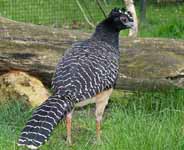

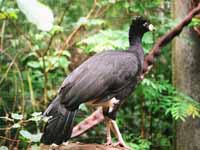
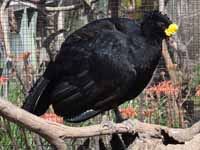
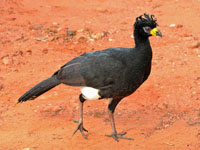
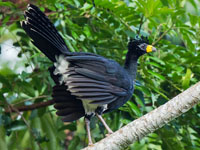
Curassow,_Black Crax alector Found: northern South America
The Black Curassow has black upperparts, head, breast; white belly; yellow or orange bill with gray tip; blue-gray legs. Female has white spots on crest.
Similar to: Bare-faced Curassow. Black Curassow has lusher crest than Bare-faced Curassow. Bare-face Curassow has more bare skin on face than Black Curassow.
Image by: 1) Alberto Apollaro 2) Jerry 3) Allan_Hopkins 4) Dave_Curtis - GuyanaSimilar to: Bare-faced Curassow. Black Curassow has lusher crest than Bare-faced Curassow. Bare-face Curassow has more bare skin on face than Black Curassow.

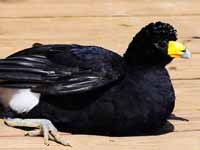
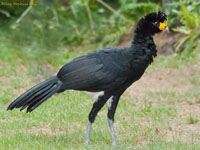
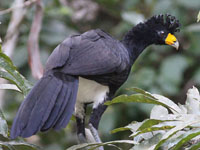
Curassow,_Blue-billed Crax alberti Found: Columbia
The male Blue-billed Curassow has black upperparts, head, breast; white belly; white-tipped tail; blue bill with gray tip; bare eye-ring; gray legs. Female has black upperparts, head, breast with white bars; cinnamon belly; gray bill; bare eye-ring; pink legs. Josh_More
Image by: 1) Josh_More 2) Hillary Colton - National Zoo 3) Patrick Coin - Jacksonville Zoo 4) Dick Daniels - Woodland Park Zoo, Seattle 1, 2) Female 3, 4) Male
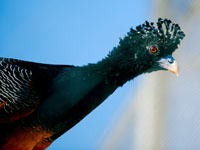
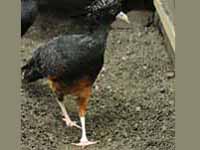
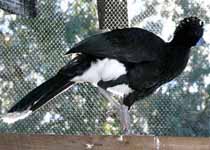

Curassow,_Great Crax rubra Found: Central America and northern South America
The male Great Curassow has black plumage with a curly crest; white belly; a yellow knob on its bill. Female has three morphs: barred morph with barred neck, mantle, wings and tail; rufous morph with an overall reddish brown plumage and a barred tail; dark morph with a blackish neck, mantle and tail. It is the heaviest species in the family. The only member of its genus that is found in Central America.
Image by:1( Andy_Morffew - Costa Rica 2, 3) Tambako The Jaguar - Brazil 4) Arthur Chapman - Panama 5, 8) Nick Athanas - Costa Rica 6) Cuatrok77 7) Jerry Oldenettel - Guatemala 1) Pair 2 - 5) Female 4) Rufous morph female 5 - 8) Male

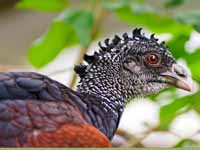
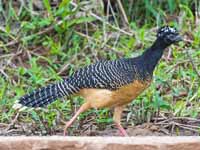
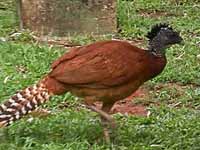

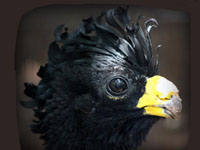
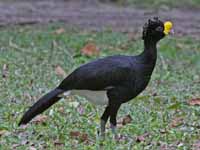

Curassow,_Red-billed Crax blumenbachii Found: Brazil
The male Red-billed Curassow has black upperparts, head, breast; white belly; white-tipped tail; reddish bill with gray tip; gray legs. Female has black upperparts, head, breast; rufous barring on wings, upper belly; cinnamon belly; gray bill; pink legs .
Image by: 1) Claudio Timm 2) Alberto Apollaro 3) Brendan_Ryan1) Female 2, 3) Male
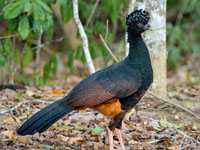

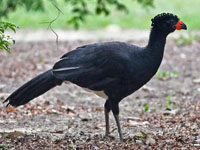
Curassow,_Wattled Crax globulosa Found: South America
The Wattled Curassow has black plumage. Male has knobs on bill.
Image by: 1. 2) Dick Daniels - National Aviary 3) Brian_Henderson 4) Takomabibelot1. 2) Pair (male in front) 3) Female 4) Male

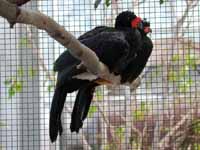
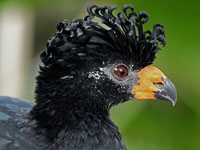

Curassow,_Yellow-knobbed Crax daubentoni Found: South America
The Yellow-knobbed Curassow has mainly black plumage; white lower belly. Male has yellow knob on gray bill; female has gray bill.
Image by: 1, 5) Sandy Cole - Sylvan Heights 2, 3, 4) Dick Daniels - Sylvan Heights
5) Granelia Bermúdez 6) Barloventomagico1 - 4) Female 5, 6, 7) Male
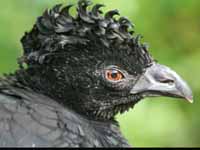
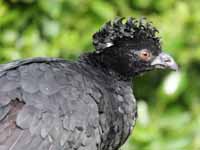



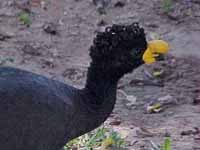
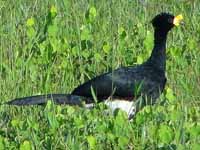
Genus Mitu
The mitu have mainly iridescent black; red legs, tail,. The genders are alike.
Curassow,_Crestless Mitu tomentosum Found: Brazil, Colombia, Guyana, Venezuela
The Crestless Curassow has mainly black plumage; glossed dark blue to purple; chestnut belly; red blil, legs; no crest.
Image by: 1) Biodiversity Library
Curassow,_Razor-billed Mitu tuberosum Found: South America
The Razor-billed Curassow has mainly black plumage; narrow (razor like) red bill, legs; white tipped tail.
Image by:
1) P Henne 2) lotlhmoq 3) Nick Athanas - Brazil
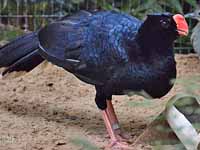
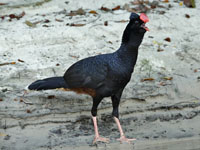
Curassow,_Salvin's Mitu salvini Found: Colombia, Ecuador, Peru
The Salvin's Curassow has black upperparts; neck, breast; white belly, tail tip; red bill, legs.
Image by: 1) Smithsonian Wild 2) eMammel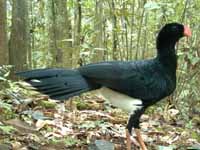
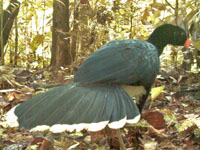
Genus Nothocrax - 1 species
Curassow,_Nocturnal Nothocrax urumutum Found: Brazil, Colombia, Ecuador, Peru,Venezuela
The Nocturnal Curassow has mainly chesntut-brown plumage. In addition to night time, it may be found in the early morning.
Image by: 1) Jelle Oostrom 2) Smithsonian Wild - Peru
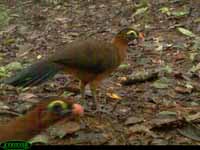
Genus Oreophasis - 1 species
Guan,_Horned Oreophasis derbianus Found: Mexico, Guatamala
The Horned Guan has glossy black upperparts, head; white underparts; red legs; yellow bill; red horn on top o fhead.
Image by:
1) Josh More 2) Yinan Chen 3) Amy McAndrews - Chiapas, Mexico

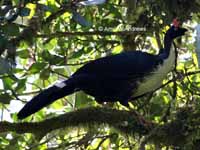
Genus Ortalis
Chachalacas are long necked, mainly brown birds found in wooded habitats. They are social, can be very noisy. They somewhat resemble the guans.
Chachalaca,_Buff-browed Ortalis superciliaris Found: northeastern Brazil
The Buff-browed Chachalaca has dark brown upperparts; pale brown underparts; pale buff supercilium.
Image by: 1) Claudi Timm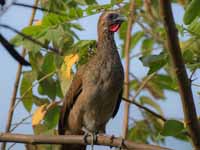
Chachalaca,_Chaco Ortalis canicollis Found: South America
The Chaco Chachalaca has olive-gray back; gray-brown wings; gray head, neck, breast; cinnamon belly, rump. It
is found in Argentina, Bolivia, Brazil, Paraguay, and Uruguay.
Image by: 1) Dario Sanches - Brazil 2) Alistair Rae - Brazil 3) Nick_Athanas - Brazil 4) Daniele Columbo - Brazil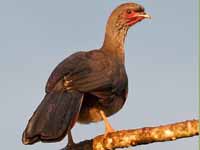
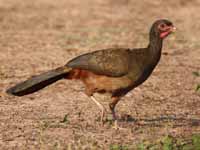
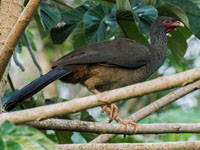
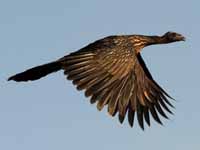
Chachalaca,_Chestnut-winged Ortalis garrula Found: Columbia
The Chestnut-winged Chachalaca has brown upperpart; pale underparts; rufescent head; chestnut primaries.
Image by: 1) Diego Calderon 2) Oswaldo Cortes 3) Mateo_Gable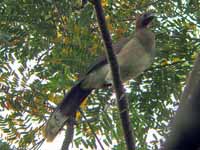

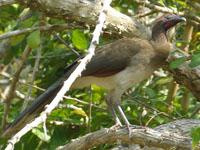
Chachalaca,_Columbian Ortalis columbiana Found: Columbia
The Columbian Chachalaca has brown upperparts; speckled lower neck, upper breast; buff belly; gray head.
Similar to: Speckled Chachalaca.
Image by: 1) Mateo Gable 2, 3) Alejandro Tamayo 4) Nick_Athanas Similar to: Speckled Chachalaca.
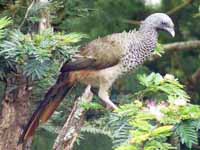
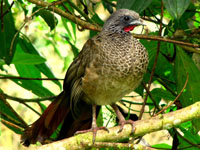
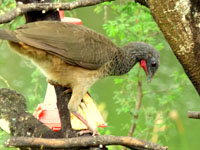
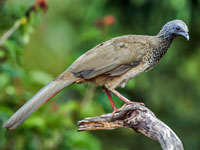
Chachalaca,_East Brazilian Ortalis araucuan Found: eastern Brazil
The East Brazilian Chachalaca was previously consider a subspecie of the Speckled Chachalaca.
Image by: 1) Alex Popovkin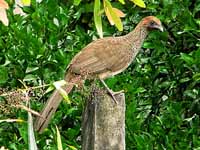
Chachalaca,_Gray-headed Ortalis cinereiceps Found: Honduras to Columbia
The Gray-headed Chachalaca has brown upperparts; gray head, neck; buff underparts; blackish tail tipped with pale gray-brown.
Image by: 1) Paul Bedel 2, 5) Nick_Athanas - Panama, Costa Rica 3) Cathy and Sam - Costa Rica 4) Wanja Krah 6) Joseph_Boone1) Pair

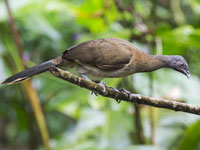
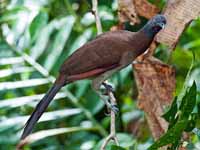

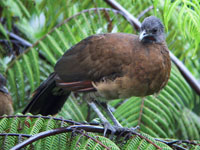
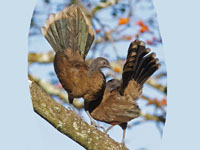
Chachalaca,_Plain Ortalis vetula Found: southern Texas to northern Costa Rica
The Plain Chachalaca is long-necked with a small head and bare throat. Adults have a greyish head and neck with a dull olive-brown body and wings. The underbelly is pale to ochraceous and the tail is blackish with green gloss and buffy-white tip. The iris is brown and bill is black; orbital skin and the feet are dull grey.
Image by: 1) Alan D. Wilson - Texas 2) Jerry Oldenettel - Texas 3) Dennis Jarvis - Belize 4) Carol Foil - Belize
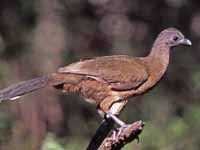


Chachalaca, Rufous-bellied Ortalis wagleri Found: Mexico
The Rufous-bellied Chachalaca has gray-brown upperparts, neck, breast; chestnut belly, under-tail coverts; blackish upper-tail; grayish bill; amber eyes; reddish naked skin around eyes
Image by:
1) John Gerrard Keulemans 2) Don Loarie 3) Roberto_González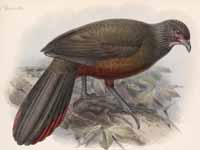


Chachalaca,_Rufous-headed Ortalis erythroptera Found: Columbia, Ecuador, Peru
The Rufous-headed Chachalaca has brownish-olive upperparts; rusty-colored head, neck; buff belly.
Image by: 1, 2) Francesco Veronesi - Ecuador 2) Nick_Athanas - Ecuador
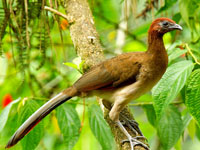

Chachalaca,_Rufous-vented Ortalis ruficauda Found: Columbia, Venezuela, Tobago
The Rufous-vented Chachalaca has dark brown upperparts; gray head, neck; buff underparts.
Image by: 1) Fernando_Flores - Venezuela 2) Barloventomagico 3, 4) New Jersy Birds 5) Dominic Sherony 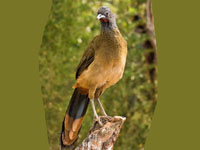
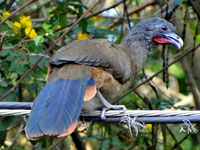
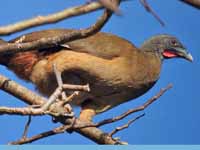
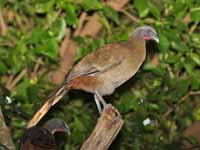

Chacalaca,_Scaled Ortalis squamata Found: southeast Brazil
The Scaled Chacalaca used to be a subspecies of the Speckled Chacalaca
Image by: 1) Nick_Athanas - Brazil 2) Claudio Timm - Brazil 3) Brendan_Ryan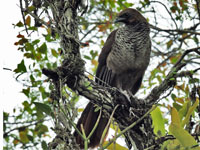
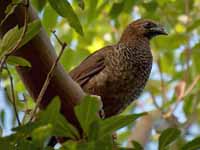
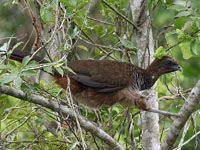
Chachalaca,_Speckled Ortalis guttata Found: South America (western Amazon Basin)
The Speckled Chachalaca has brown upperparts; speckled lower neck, upper breast; buff belly.The East Brazilian Chachalaca was previously consider a subspecie of the Speckled Chachalaca.
Similar to: Columbian Chachalaca.
Image by: 1) Nick_Athanas - Ecuador 2) Sergey_Pisarevskiy - Bolivia 3) Joao_Quental 4) Felix_Uribe - ColumbiaSimilar to: Columbian Chachalaca.

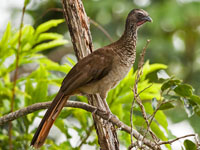
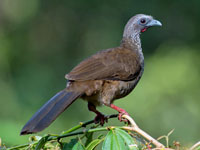
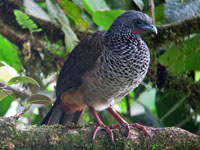
Chachalaca,_West_Mexcian Ortalis poliocephala Found: southwestern Mexico
The West Mexican Chachalaca has grayish-brown upperparts, head, neck, upper-breast; white belly; cinnamon under-tail.
Similar to: White-bellied Chachalaca. The White-bellied Chachalacs hsd white under-tail; West Mexican Chachalaca has cinnamon under-tail.
Image by: 1) Cloned Milkmen 2) Francesco Veronesi 3) Dick_CulbertSimilar to: White-bellied Chachalaca. The White-bellied Chachalacs hsd white under-tail; West Mexican Chachalaca has cinnamon under-tail.
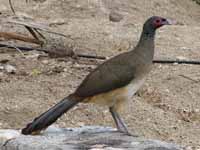
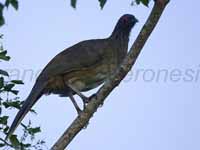
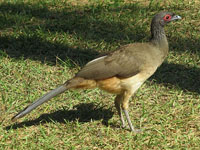
Chachalaca,_White-bellied Ortalis leucogastra Found: southern Mexico to Nicaragua
The White-bellied Chachalaca has brownish upperparts, breast; white belly, under-tail.
Similar to: West Mexican Chachalaca. The White-bellied Chachalacs hsd white under-tail; West Mexican Chachalaca has cinnamon under-tail.
Image by: 1) Jerry Oldenettel - Chiapas, Mexico 2) Nick_Athanas - MexicoSimilar to: West Mexican Chachalaca. The White-bellied Chachalacs hsd white under-tail; West Mexican Chachalaca has cinnamon under-tail.
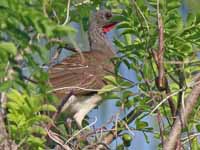

Genus Pauxi
Curassow,_Helmeted also Northern Helmeted Curassow Pauxi pauxi Found: Columbia, Venezuela
The male Helmeted Curassow has glossy black plumage; white belly, rump; bluish-white knob on forehead; red bill. Female has 2 morphs: one like male with no knob. Other morph has black head, neck; brown upperparts, breast; cream belly, rump.
Image by: 1) Sandy Cole - San Diego Zoo 2, 3, 4) Dick
Daniels - San Diego Zoo
5) Mattei Tarenghi 6) Greg Hume1, 2, 3) Female 4) Male According to Wikipedia, other females are similar to the male!

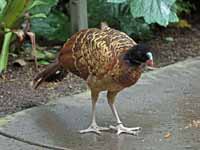
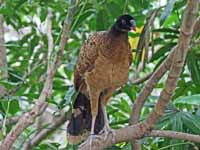
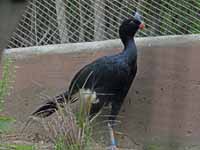
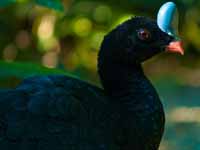
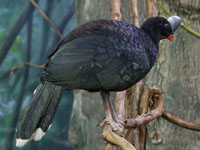
Curassow,_Horned Pauxi unicornis Found: Bolivia
The Horned Curassow has mainly black plumage; white belly, thigh tufts, under-tail coverts.
Image by:
1) Peter Stubbs
Genus Penelope
There are two guan genus; see also Chamaepetes.
The penelopes contain large turkey-like arboreal species. The range of these species is in forests from southern Mexico to tropical South America. These largish birds have predominately brown plumage and have relatively small heads in comparison with body size.
Guan,_Andean Penelope montagnii Found: mainly Columbia, Ecuador, Peru, Venezuela; also Bolivia
The Andean Guan has brown plumage with whitish edging to feathers of head, neck, breast; small red wattle on throat. It occurs in the highlands of the Andes, from Venezuela and Colombia through Ecuador and Peru south to Bolivia.
Image by: 1) Petruss 2) Peter Bono 3) Nick Athanas - Peru 4) Brendan_Ryan - Columbia
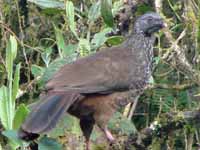
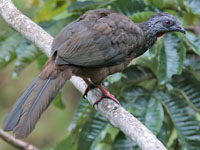
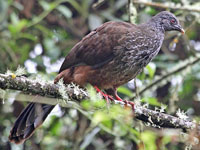
Guan,_Band-tailed Penelope argyrotis Found: Columbia, Venezuela
The Band-tailed Guan has dark rufous-brown upperparts; olive-brown underparts.
Image by: 1, 2) Jerry Oldenettel 3) Nick Athanas - Columbia 4) Sergey_Pisarevskiy - Columbia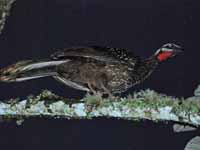
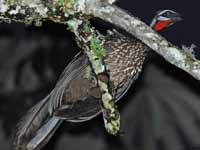
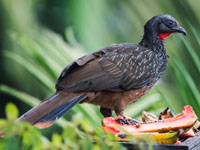
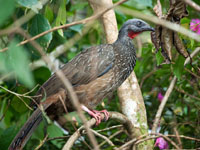
Guan,_Baudo Penelope ortoni Found: western Columbia, northwest Ecuador
The Baudo Guan is the only Penelope guan that has no pale markings on the head.
Image by: 1) Scott Olmstead - Ecuador 2) Finn_Frank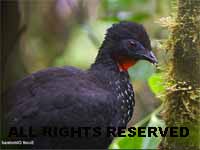
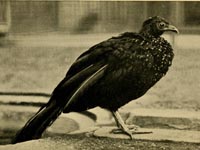
Guan,_Bearded Penelope barbata Found: Ecuador, Peru
The Bearded Guan has mainly brown plumage; silvering on crown, neck; red legs.
Image by: 1) Francesco Veronesi - Ecuador 2, 3) Nick_Athanas - Ecuador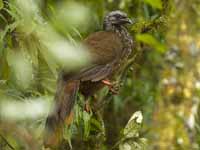

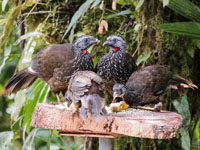
Guan,_Cauca Penelope perspicax Found: Columbia
The Cauca Guan has mainly brownish-gray plumage; chestnut aft underparts; bright red dewlap under chin.
Image by: 1) Sergey Pisarevskiy 2) Brendan_Ryan 3) Nick Athanas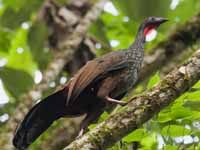

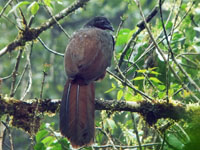
Guan,_Chestnut-bellied Penelope ochrogaster Found: Brazil
The Chestnut-bellied Guan has brown upperparts; chestnut-rufous underparts flecked with white.
Image by: 1, 2) Claudio Timm 3) Nick Athanas 4) Andreas_Trepte 5) Bernard_Dupont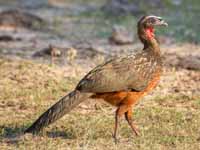
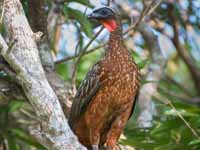



Guan,_Crested Penelope purpurascens Found: Central America, northern South America
The Crested Guan has brown upperparts; brown chest with white speckles; rufous belly, rump; blue-gray bare skin around eye; heavy blil; thick crest; red throat wattle.
Similar to: Spix's Guan. Crested Guan has readily apparent crest; Spix's Guan has no crest.
Image by: 1) Jerry Oldenettel - Costa Rica 2) Howard_Patterson - Costa Rica 3) Jorge Montejo - Mexico 4) Nick_Athanas - Costa RicaSimilar to: Spix's Guan. Crested Guan has readily apparent crest; Spix's Guan has no crest.
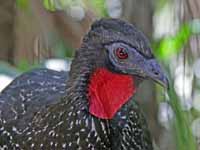
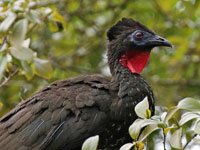
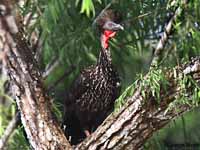
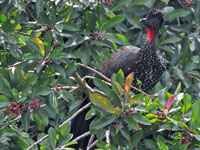
Guan,_Dusky-legged Penelope obscura Found: South America
The Dusky-legged Guan has dark gray legs; brown upperparts, neck and breast all of which have white-edged feathers; darker head, tail; bare gray face; red wattle on throat.
Similar to: Red-faced Guan. The Red-faced Guan has some red on its face; the Dusky-legged Guan does not.
Similar to: Rusty-margined Guan. Rusty-margined Guan has a more reddish tinge than Dusky-legged Guan.
Image by: 1, 2) Nick Athanas - Brazil 3) Tude_e_Joao 4) Andreas_Trepte 5, 6)
Dario Sanches - BrazilSimilar to: Red-faced Guan. The Red-faced Guan has some red on its face; the Dusky-legged Guan does not.
Similar to: Rusty-margined Guan. Rusty-margined Guan has a more reddish tinge than Dusky-legged Guan.
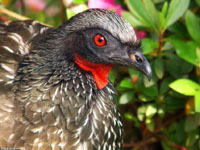
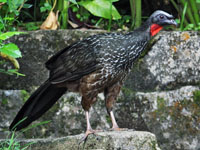

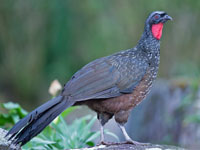


Guan,_Red-faced Penelope dabbenei Found: Argentina, Bolivia
Similar to: Dusky-legged Guan. The Red-faced Guan has some red on its face; the Dusky-legged Guan does not.
Image by: 1) Freddy_Burgos - Argentina 2) Nick_Athanas
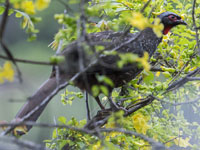
Guan,_Rusty-margined Penelope superciliaris Found: mainly Brazil; also Argentina, Bolivia, Paraguay
The Rusty-margined Guan has dark gray belly with reddish tinge; chestnut back; dark brown head, neck; reddish legs; bluish-gray facial skin;
Similar to: Dusky-legged Guan. Rusty-margined Guan has a more reddish tinge than Dusky-legged Guan.
Image by: 1) Fabio Maffei - Brazil 2) Zimbres - Brazil 3) Nick_Athanas - Brazil 4) Luiz Carlos Rocha - BrazilSimilar to: Dusky-legged Guan. Rusty-margined Guan has a more reddish tinge than Dusky-legged Guan.



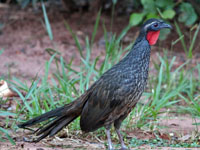
Guan,_Spix's Penelope jacquacu Found: South America
The Spix's Guan has brown upperparts, breast; chestnut belly; white scaly look on back, breast.
Similar to: Crested Guan. Crested Guan has readily apparent crest; Spix's Guan has no crest.
Image by: 1) Frank_Wouters 2) Arthur Chapman 3) YamezA - Peru 5) Nick Athanas - BrazilSimilar to: Crested Guan. Crested Guan has readily apparent crest; Spix's Guan has no crest.
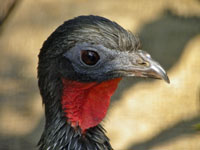
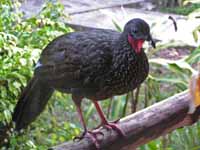
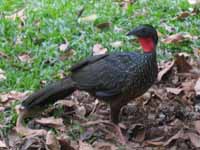
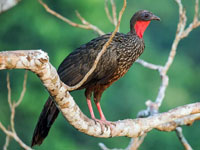
Guan,_White-browed Penelope jacucaca Found: northeast Brazil
The White-browed Guan has blackish-brown plumage; white supercilium
Image by: 1) BioDivLib 2) Arthur Grosset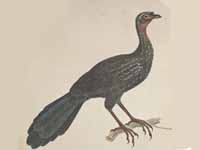
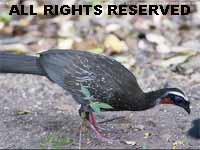
Guan,_White-crested Penelope pileata Found: Brazil
The White-crested Guan has dark green upperparts; chestnut colored underparts.
Image by: 1) Nick Athanas 2) Claudio_Timm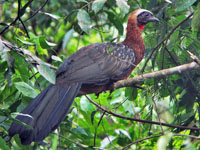
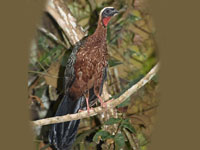
Guan,_White-winged Penelope albipennis Found: Peru
No other guan is known to share White-winged Guan's range.
Image by: 1, 2, 3)
David Cook - Peru 4) Nick Athanas 5) Tuija_Sonkkila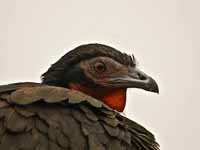

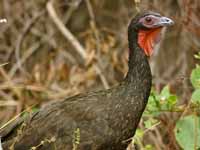
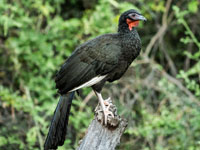
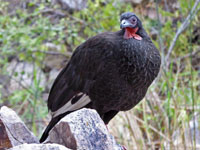
Genus Penelopina - 1 species
Guan,_Highland Penelopina nigra Found: highlands of Mexico, Central America
The male Highland Guan has blue-black plumage; red wattle, bill; blue skin around the eyes.Female has rufous-brown plumage; red bill; blue skin around the eyes.
Image by: 1) Josphe Wolf 2) Fernando Reyes Palencia - Guatemala
3) Amy McAndrews - Mexico 4) Jorge Montejo - Mexico 5) Nick Athanas - Mexico1) Pair 2, 3, 4, 5) Male
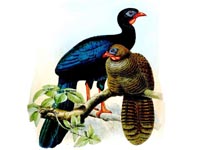
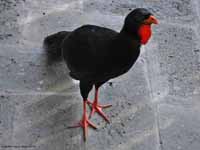

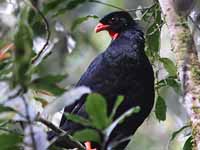

Genus Pipile
The piping-guans.
Guan,_Black-fronted Piping- Pipile jacutinga Found: Brazil, Argentina, Paraguay
The Black-fronted Piping-Guan has blue-black plumage; white head, nape; black forehead; bold white eye-ring; white patch on wings.
Similar to: Blue-throated Piping-Guan. Black-fronted Piping-Guan has bold white eye-ring; Blue-throated Piping-Guan has white face.
Image by: 1) Bruno Girin - Brazil 2) Alexandre Augusto - Brazil 3) lotlhmoq 4) Nick Athanas - BrazilSimilar to: Blue-throated Piping-Guan. Black-fronted Piping-Guan has bold white eye-ring; Blue-throated Piping-Guan has white face.
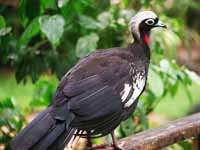
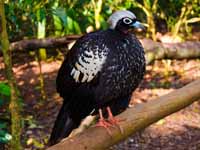
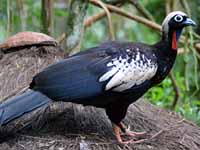
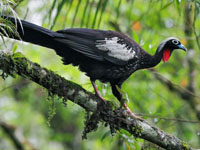
Guan,_Blue-throated Piping- Pipile cumanensis Found: South America
The Blue-throated Piping-Guan has blue-black plumage; white head, nape; white forehead; white patch on wings.
Similar to: Black-fronted Piping-Guan. Black-fronted Piping-Guan has bold white eye-ring; Blue-throated Piping-Guan has white face.
Image by: 1, 2) Dick Daniels - San Francisco Zoo 3) Drew Avery 4) Joao_Quental - PeruSimilar to: Black-fronted Piping-Guan. Black-fronted Piping-Guan has bold white eye-ring; Blue-throated Piping-Guan has white face.
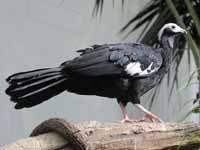
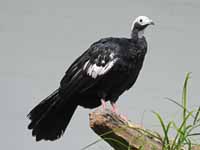
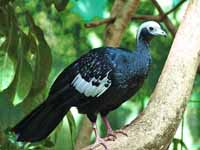
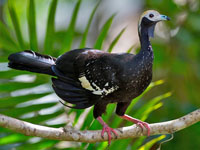
Guan,_Red-throated Piping Pipile cujubi Found: Bolivia, Brazil
The Red-throated Piping-Guan has mainly black plumage; white patches on upper-wing covert; white crest; some blue facial skin; red gular patch on throat.
Image by: 1) Claudio Timm 2) Amy McAndrews 3, 4) Bernard_Dupont - Brazil